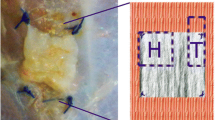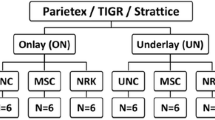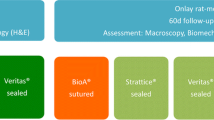Abstract
Background
Coating prosthetic for hernia repair with a patient’s own cells could improve biocompatibility by decreasing inflammation and adhesion formation and by increasing tissue ingrowth and resistance to infection. The objective of this study was to prove the feasibility of prosthetic coating with stem cells and to assess its resistance to adhesion formation when implanted in an animal model.
Methods
Adult Lewis rat bone marrow stem cells were harvested and cultured. Stem cells were then implanted on three different prosthetics. The prosthetic with the best stem cell adherence was implanted intraperitoneally into six adult rats. Untreated prosthetic was implanted in control animals (n = 12). After 2 weeks, intra-abdominal adhesions were graded using an adhesion scoring scale by two surgeons who were blinded to the animal group. Data were analyzed using the Wilcoxon rank-sum test.
Results
Stem cells demonstrated the best adherence and growth on polyglactin prosthetics. After implantation, the stem cell-coated polyglactin prosthetic had <25% of its surface area covered with adhesions in five (83%) samples, whereas the control polyglactin group had only one sample (8.3%) with <25% adhesions, and seven of its samples (58.3%) had >50% surface area adhesions (p < 0.05).
Conclusions
The feasibility of hernia prosthetic coating with stem cells was demonstrated. Furthermore, stem-cell coated polyglactin prosthetic exhibited improved biocompatibility by decreasing adhesion formation in an animal model. Further study is needed to determine the factors that promote stem cell adherence to prosthetics and the in vivo prosthetic biomechanics after stem cell coating. This work is underway in our laboratory.






Similar content being viewed by others
References
Fraser JK, Schreiber R, Strem B, Zhu M, Alfonso Z, Wulur I, Hedrick MH (2006) Plasticity of human adipose stem cells toward endothelial cells and cardiomyocytes. Nat Clin Pract Cardiovasc Med 3(Suppl 1):S33–S37
Fan H, Hu Y, Zhang C, Li X, Lv R, Qin L, Zhu R (2006) Cartilage regeneration using mesenchymal stem cells and a PLGA-gelatin/chondroitin/hyaluronate hybrid scaffold. Biomaterials 27:4573–4580
Wu W, Feng X, Mao T, Feng X, Ouyang HW, Zhao G, Chen F (2007) Engineering of human tracheal tissue with collagen-enforced poly-lactic-glycolic acid non-woven mesh: a preliminary study in nude mice. Br J Oral Maxillofac Surg 45:272–278
Kyzer S, Kadouri A, Levi A, Ramadan E, Levinsky H, Halpern M, Chaimoff C (1997) Repair of fascia with polyglycolic acid mesh cultured with fibroblasts–experimental study. Eur Surg Res 29:84–92
Kay S, Thapa A, Haberstroh KM, Webster TJ (2002) Nanostructured polymer/nanophase ceramic composites enhance osteoblast and chondrocyte adhesion. Tissue Eng 8:753–761
Park GE, Pattison MA, Park K, Webster TJ (2005) Accelerated chondrocyte functions on NaOH-treated PLGA scaffolds. Biomaterials 26:3075–3082
Yoon JJ, Nam YS, Kim JH, Park TG (2002) Surface immobilization of galactose onto aliphatic biodegradable polymers for hepatocyte culture. Biotechnol Bioeng 78:1–10
Olivares EL, Ribeiro VP, Werneck de Castro JP, Ribeiro KC, Mattos EC, Goldenberg RC, Mill JG, Dohmann HF, dos Santos RR, de Carvalho AC, Masuda MO (2004) Bone marrow stromal cells improve cardiac performance in healed infarcted rat hearts. Am J Physiol Heart Circ Physiol 287:H464–H470
Shin M, Abukawa H, Troulis MJ, Vacanti JP (2007) Development of a biodegradable scaffold with interconnected pores by heat fusion and its application to bone tissue engineering. J Biomed Mater Res A 84A:702–709
Kapischke M, Prinz K, Tepel J, Tensfeldt J, Schulz T (2005) Precoating of alloplastic materials with living human fibroblasts: a feasibility study. Surg Endosc 19:791–797
Cobb WS, Kercher KW, Heniford BT (2005) The argument for lightweight polypropylene mesh in hernia repair. Surg Innov 12:63–69
Liu HW, Chen CH, Tsai CL, Lin IH, Hsiue GH (2007) Heterobifunctional poly(ethylene glycol)-tethered bone morphogenetic protein-2-stimulated bone marrow mesenchymal stromal cell differentiation and osteogenesis. Tissue Eng 13:1113–1124
Klinge U, Klosterhalfen B, Birkenhauer V, Junge K, Conze J, Schumpelick V (2002) Impact of polymer pore size on the interface scar formation in a rat model. J Surg Res 103:208–214
Acknowledgments
This study was in part funded by the Society of American Gastrointestinal and Endoscopic Surgeons.
Disclosures
Drs. Charles J. Dolce, Dimitrios Stefanidis, Jennifer E. Keller, K. Christian Walters, William L. Newcomb, H. James Norton, Amy E. Lincourt, Kent W. Kercher, B. Todd Heniford, and Jessica J. Heath, have no conflicts of interest or financial ties to disclose.
Author information
Authors and Affiliations
Corresponding author
Rights and permissions
About this article
Cite this article
Dolce, C.J., Stefanidis, D., Keller, J.E. et al. Pushing the envelope in biomaterial research: initial results of prosthetic coating with stem cells in a rat model. Surg Endosc 24, 2687–2693 (2010). https://doi.org/10.1007/s00464-010-1026-x
Received:
Accepted:
Published:
Issue Date:
DOI: https://doi.org/10.1007/s00464-010-1026-x




